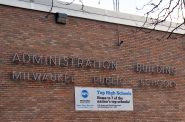Why School Funding Referendums Fail
Why did so many in the state pass while the West Allis referendum failed?
The largest monetary school referendum attempted in Wisconsin was $399 million by Milwaukee Public Schools in 1993. It failed. It took until 2020 before the district would consider another referendum.
This time around, the district asked for a more realistic amount: $87 million. MPS also made sure it got as many segments of the community on board as possible including the realtors who saw good schools as important as property tax rates in selling homes. One of the cochairs of the MPS taskforce was Peter Feigin, president of the Milwaukee Bucks. Who could be against if the Bucks were on board? This time it passed.
But first, Lexmond had to acknowledge the mistakes of the past. A previous superintendent had burned through the cash reserves. The district was also involved in a bad investment scheme that cost it millions of dollars.
Lexmond was shocked by how bad the district’s finances were when he took over. “We’re trying to rebuild those reserves,” said Lexmond.
To bridge the gap, the board asked for $12.5 million in 2017, $2.5 million for each of five years in an operating referendum. The voters said “NO.”
So Lexmond and the board tried another solution: To avoid increasing class sizes too much and avoid cutting programs, they sold off several buildings including the central administration building, raising $6.75 million.
Lexmond was proud that WAWM had improved its bond rating from a dismal “B” to a respectable “AA.” This board and superintendent were showing they knew how to handle money. Lexmond was now telling the public that, in order to be good financial stewards, they had to spend some money, this time to the tune of nearly $150 million in a referendum.
WAWM has a shrinking student population. The district had 2,500 high school students, but by 2030, that number will drop to 1,923.
The district would close a couple of elementary schools and combine the two high schools. The district would save two to three million dollars in operating costs per year and could improve the high school educational experience because it had a deal with Milwaukee Area Technical College. MATC has aging buildings in the area. If WAWM would build new facilities, MATC would provide the equipment that high school students could use during the day and MATC students at night and on weekends. High school students could earn associate degrees and credits for college.
The plan was to close Central High School and expand Nathan Hale High School on the western edge of the district. Lexmond acknowledged that it would be preferable to have a central location, but Central was a much older building and little additional space was available at that site. But this raised additional issues.
As Lexmond recognized, there was an east-west divide in his district. It appeared that the more affluent western neighborhoods were winning out over the poorer and working-class eastern neighborhoods with the decision to close Central and expand Hale.
“Any time you are closing schools or changing attendance boundaries, that is a very political decision,” says Dan Rossmiller, director of government relations for the Wisconsin Association of School Boards. “People buy their houses and decide where to live and where to open a business depends upon what school is going to serve their kids and how far they are going to travel… What is one of the first things a realtor tells you about a house, especially if you have a family? What are the schools like? How far is it to school? Can students walk or do they have to ride a bus?”
At a school board meeting just before the election, one voter asked “Do you think the public is just full of money? I would encourage you on spending your money educating people, not on buildings… Buildings don’t educate; teachers do.”
“Taj Mahal at Hale,” said another.
The referendum lost in every ward except one, with 4,146 votes or 41% for and 5,965 votes or 59% against.
Postmortem
Operating referenda are often efforts for voters to keep what they already have. But a referendum that boldly goes into the unknown may require a leap of faith. That is what WAWM voters were being asked, and the referendum was not even keeping what they had in closing some buildings.
Perhaps the district could revisit consolidation of the high schools somewhere down the road, but only after the district had made more hard choices in closing unnecessary buildings. That meant that the cooperative arrangement with MATC is off the table for now and perhaps for good.
Some board members had a difficult time recommending closing some schools because their own children attended those schools. They asked the administration to take “another look” at the buildings and data to determine whether this or that school needed to be closed.
Parents and teachers were already coming out to oppose the closing of their elementary schools while other citizens cried out, “Sell all unnecessary school buildings and consolidate.” The community appears paralyzed in how to move forward.
All Referenda Are Not Equal
In the April 5 election, nearly 80% of all Wisconsin school referenda passed. The rate has been going up for years: Every annual referendum passing rate after 2011 except one was higher than any rate that came before.
But before 2011, districts could go for a referendum at any time, even hold a special referendum vote outside of the regular election cycle and go to the voters as many times as they wished in a single year. Some referenda were “trial balloons” — if they didn’t pass, the districts could simply restructure and go back to the voters. A lot of referenda didn’t pass.
Rob DeMeuse is research director at School Perceptions, which provides educational surveys including analysis of public support to school referenda. His 2020 PhD UW-Madison dissertation is entitled, “Check Yes or No: Identifying Factors That Predict Rural Wisconsin Public School District Referendum Passage.” He provided additional information in a phone interview with Urban Milwaukee.
DeMeuse says it is a misperception that referenda increased after the passage of revenue caps and Act 10. In reality, there were more referenda before 2011 than after. What changed was the dollar amount. For the ten years before 2011, $999 million in spending was approved for operational referenda. In the 10 years since 2011, the dollar amount approved jumped to $3.9 billion.
“A lot of these referenda do not pass by overwhelming margins, Rossmiller notes. “After all, people are being asked to raise taxes on themselves.” Looking at the April election he divides the school referendums in the state into building referenda for which the passage rate was not as good, “as only 25 of 35 (71 percent) passed,” and “operating referenda which were temporary in nature,” where “the overwhelming majority—35 of 38 (92%) passed.”
When voters are asked to reauthorize an operating referendum that has expired after three years, the voters are not being asked to do something new; they are just being asked if the district should continue doing what it has been doing. What might change is the amount of money the districts are asking in the new operating referendum.
What Works
“Wanna pass a referendum? Win a football championship,” writes DeMeuse in the May 2022 issue of School News. Sports success can unite a school district.
The company DeMeuse work for, School Perceptions, tells a district what voters are saying through polling and interviews but doesn’t say what the district should do or how they should present the referendum to the voters. DeMeuse says they are 95% accurate at predicting a referendum’s result.
Republican districts are just as likely to support a referendum as a liberal, Democratic district, says DeMeuse. Nor does income and educational level of its citizens make much difference.
A common belief is lower turnout favors passage. Not true, says DeMause. All things being equal, referenda that might fail in April could do better in November when more candidates are on the ballot.
A lot of things can happen after a survey is taken says DeMeuse in a phone interview. This year we have seen a dramatic rise in inflation and interest rates, so that Ford pickup a farmer drives is costing a lot more to fill up, he notes. And that school construction project is now going to cost a lot more. Voters are going to think twice about supporting a referendum they might have supported just a few months ago.
DeMeuse says districts must ask three questions and provide answers to their voters:
- Where is the money going?
- Why is that project needed?
- Why is that project needed now?
In gaining the public support for a referendum, presenting factual information is only half the battle. There is a lot of emotion involved as well.
The referendum in WAWM may have died by a thousand cuts. It wasn’t just the price tag. The district had mishandled money in the past. Eliminating schools is always difficult. Creating 21st century education is a hard sell when much of the public thinks the old ways are the best.
What may undo a school referendum is a loss of community trust or a lack of shared vision. It is all about the money until it isn’t.
If you think stories like this are important, become a member of Urban Milwaukee and help support real, independent journalism. Plus you get some cool added benefits.
K-12 Education
-
MPS Training in Science of Reading Going Poorly
 Nov 23rd, 2025 by Terry Falk
Nov 23rd, 2025 by Terry Falk
-
The Fear Factor at MPS
 Nov 11th, 2025 by Terry Falk
Nov 11th, 2025 by Terry Falk
-
MPS Reaching Out to Community
 Nov 2nd, 2025 by Terry Falk
Nov 2nd, 2025 by Terry Falk






















